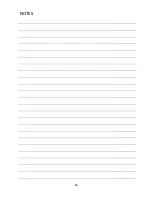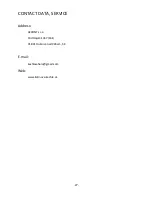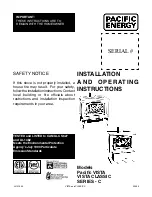
-13-
3.
Empty the ash-can and clean the space for ash-can (Fig. 1 - position b). Completely close
the ash-can door (Fig . 1- position b) up to the stopper of the ash-can door. It must
be closed.
4.
Make fire through the open loading door (Fig. 1 - position a) using thin dry soft wood
and kindling agent (you can buy it in a store) on a clean grill. Then immediately close
the loading door (Fig. 1 - position a).
5.
When the soft thin wood gets burn sufficiently, open the loading door (Fig. 1 - position
a) and add reasonable amount of slightly larger, thin, ready-made hardwood and
close the loading door (Fig. 1 -position a).
6.
When the hardwood burns in an adequate way, too, close the supply of primary sucking
combustion air to minimum (Fig. 1 - position d), open the loading door (Fig. 1 -
position a) and add the reasonable amount of thicker hardwood, you shall use to
heat with and close the loading door (Fig. 1 - position a). The primary supply of air
should be again open to maximum (Fig. 1 - position d) and after the load burns well,
set the supply of primary air (Fig. 1 – position d) to the minimum position (the
control of the secondary combustion air shall remain in MAX position), the flame
must be still. The wood can be loaded to the stove in horizontal, askew position as
well as vertically. The procedure of air adjustment must be repeated upon every
load.
7.
In a suitable time, it is necessary to poke the coals at the bottom of the grate using the
mobile grill (Fig. 1 - position c) holding the grip. Grasp the grip (Fig. 1 - position c)
and shift it several times towards you and away from you with the ash-can door
closed (Fig. 1 - position b). Use heat-resistant gloves!
Open the loading door in two strokes. At first, open the door just a little,
by approximately 1 to 2 cm, stay for ca 1 - 2 seconds in the position, still
firmly holding the white ceramic grip in your hand with a heat-resistant
glove. Then you can open it to maximum. Thus you shall restrict to
minimum the unforeseen and unwanted unpleasant spreading out of
odour and combustion products to the external area in the proximity of
the stove.
Closed stove in operation, which had prior been filled up with
recommended fuel, is to be opened only after the fuel has burned out
under the level of the lower stove edge. Otherwise there is the risk of
burn, back blaze of flame through the loading door out of the stove and
penetration of fume to the space where the stove is installed.
















































